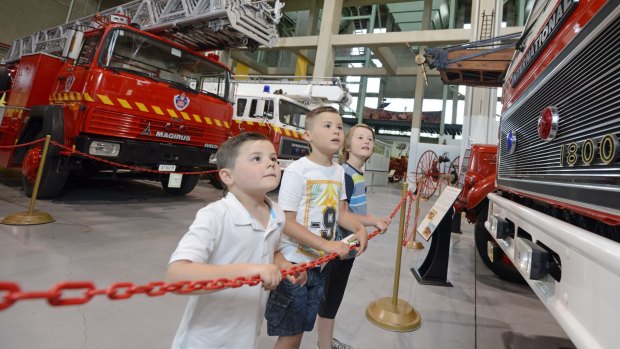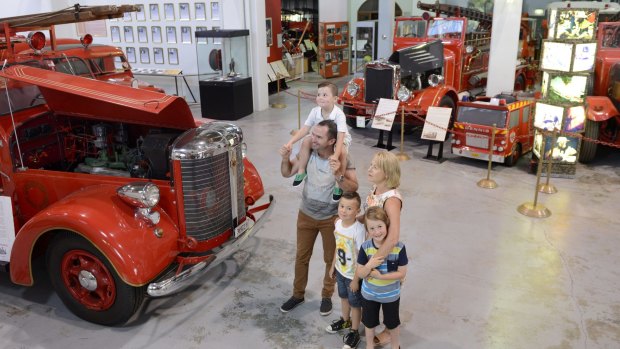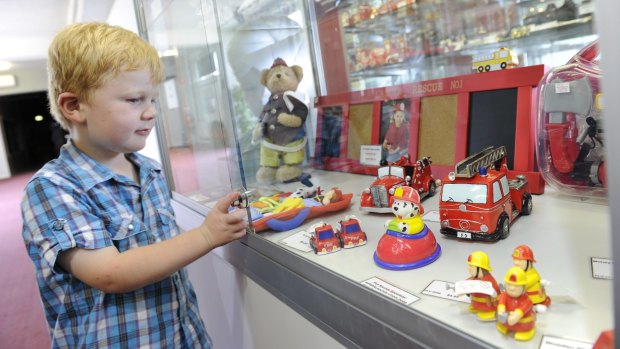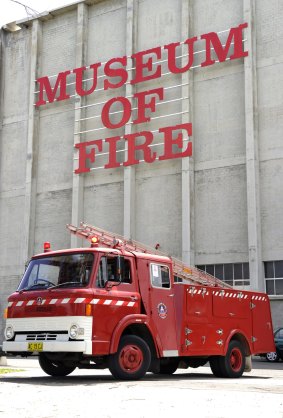By Keith Austin

Young visitors get a close-up view of the attractions.
Anyone driving along Castlereagh Road, Penrith, will have noticed the big, red fire engine on a stick not far from the junction with the Great Western Highway.
The legend below it boasts that this is the way to the Museum of Fire, but unscientific inquiries reveal that few passers-by make the short detour to see what it's all about.
"I'll get to it one day," seems the general reaction.

Museum of Fire, Penrith.
And first impressions would suggest that you're not missing much: the museum looks like a Cold War-era nuclear bunker. There are train yards to one side, the mini-pylons of an electricity substation on the other and, between them, a generally unwelcoming concrete cube that seems to have dropped out of the sky.
Inside, though, is another matter. Inside, it is filled with wonder and young children, their mouths open, agog, their parents just as enthralled.
The Museum of Fire is in a former power plant that was built for the burgeoning homes of the western suburbs in the early 1950s and closed in 1970. It has become a veritable elephants' graveyard of fire engines of every shape, size and age.

Display cabinets hold something to hold everyone's attention.
The main hall is enormous, a great echoing space filled to overflowing with hand-drawn, horse-drawn and motorised fire vehicles from the late 18th century up to the 1980s.
Interspersed among the vehicles are trophy cabinets full of the shining, ornate brass helmets, firefighting tunics, dress uniforms, badges, buttons, patches, medals and insignia from Australia and the rest of the world, as well as breathing apparatus, old heat suits, chemical suits, hoses, nozzles, branches, standpipes, axes and extinguishers.
One of the big attractions for the grown-ups is a Furphy bushfire water cart, the Victorian-made apparatus that would eventually give name to the Australian slang for a rumour or improbable story.

The bunker-like exterior of the Museum of Fire in Penrith hides a fascinating collection of firefighting equipment.
John Furphy & Sons, of Shepparton, first made the steel and cast-iron tanks in the 1880s for use on farms, but many of them ended up being taken to Europe and the Middle East by the army during World War I.
The carts, with the maker's name on the tank, travelled from camp to camp, providing both water and snippets of news. The carts became gathering places where soldiers engaged in what today would be called water cooler conversations. These little bits of gossip, rumour and dodgy yarns would eventually become "furphies".
The exhibition begins with a few facts and figures about how fire starts, and how to prevent it, before wending its way in to the main hall past an impressive wall of district station record books containing the history of local fires and the day-to-day workings of the firefighter's life from 1910 onwards.
Inside the main hall, festooned with romantic banners depicting an old-fashioned fireman gallantly rescuing a swooning woman from a burning building, you are taken on a journey through the history of firefighting and firefighters.
Here you'll learn about The Squirt, one of the first firefighting devices, invented in England in the late 16th century, essentially a syringe which, for the first time, could direct jets of water accurately and in a concentrated form at the seat of a fire.
Also, according to another information panel, the first mention of fire engines in Sydney dates back to 1822, when a chimney caught fire in the military barracks in George Street. The machines they used to extinguish the flames were later described by an onlooker as "a small coffin pulled by hand".
The museum also has a children's play area where the kids can "drive" a fire engine and interact with exhibits.
The gift shop is stuffed with fire-related toys, memorabilia, pins, medallions and action figures for young and old. My favourite? The life-size red fire hydrant ashtray, a steal at $55.
MORE INFORMATION
See museumoffire.com.au
The Museum of Fire (1 Museum Drive, Penrith) is open seven days a week from 9.30am-4.30pm. Phone 4731 3000. Ticket prices: adults $10; children aged 2-13 $6; family (two adults, two children) $25.
Sign up for the Traveller Deals newsletter
Get exclusive travel deals delivered straight to your inbox. Sign up now.